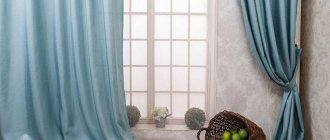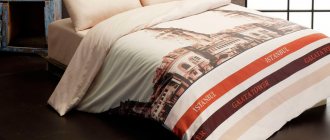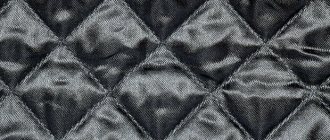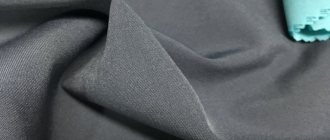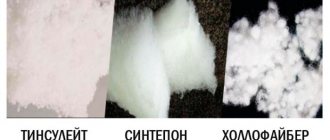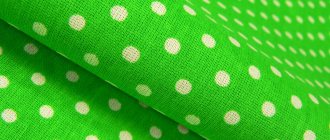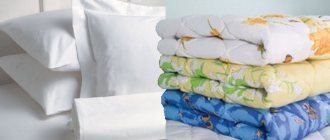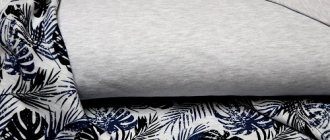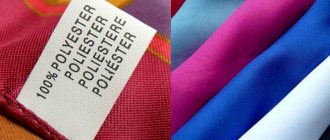general description
Polycotton began to be produced in the 20th century (late 50s). It is one of the most common mixed fabrics for sewing bedding. For example, about 80% of all hotels in the world use bedding sets made from this material.
Polyester and cotton are mixed in different proportions depending on the purpose of the fabric. Most often, the threads are woven using a simple plain weave. Externally, the fabric resembles calico. Polycotton is used to make bed linen, covers for furniture and bedding, home textiles, slings, and clothing.
How to choose quality products made from polyester material
In order to choose high-quality polyester products, you need to be extremely careful.
It is best to purchase clothing of this type directly from the wholesale warehouses of the largest domestic light industry factories, because there all products undergo technical control, and, accordingly, the likelihood of purchasing clothing with defects or from counterfeit fabric is almost zero. Recently, shopping tours to textile factories have become very popular; you can purchase such a shopping tour from any major tourism operator. A shopping tour to a textile factory is a group or individual trip to a wholesale warehouse or textile market located in close proximity to a large light industry plant. The purpose of the shopping tour is to purchase high-quality textile products wholesale or retail at competitive prices. The benefit is due to the fact that in this case the clothes are purchased directly from the manufacturer, that is, at the factory, without intermediaries and trade markups.
Another option for purchasing high-quality polyester clothing is to order online from the largest wholesale and retail online stores. However, when ordering clothes online, it is important to indicate your measurements correctly. The supplier must provide a guarantee. It is also recommended that clothing be returned within fourteen days if it does not fit.
When purchasing a polyester product, you need to pay special attention to its appearance. The surface of the jacket (raincoat, windbreaker, T-shirt or dress) should be free of dirt, abrasions, and rough seams. to purchase polyester clothes on the market, because the goods sold on the market most often do not have a quality certificate, and therefore there is a high probability of counterfeiting. Also, do not buy second-hand polyester clothing from thrift stores or second-hand outlets. If you purchase a fake, synthetic fabric of unknown origin can provoke serious allergic reactions and cause various diseases.
Fabric structure
The production of polycotton made it possible to almost completely get rid of the disadvantages inherent in fibers in their pure form. Cotton in its pure form has the following disadvantages:
- strong creasing;
- rapid loss of color;
- shrinkage;
- loss of shape even after short use.
Polyester has the following negative qualities:
- poor air conductivity;
- rigidity;
- electrification;
- poor colorability.
If polyester is heavily predominant in the composition of polycotton, the manifestation of its negative properties increases. If there are more natural raw materials, then the fabric is like cotton. It is best if the proportions of the fibers are approximately equal. The optimal ratio for bed linen is: 50% polyester and 50% cotton or 35% polyester and 65% cotton .
The quality, appearance and beneficial properties of polycotton depend on the percentage of fibers. The most common fiber combinations:
- 15% cotton and 85% polyester;
- 35% cotton and 65% polyester;
- 50% cotton and 50% polyester;
- 65% cotton and 35% polyester.
Related article: What to wear under a skirt?
Application in clothing production
An important characteristic is density, which is measured in g/m2 and affects the possibility of use in tailoring products:
- 100 - 115 g/m2 - men's and women's shirts
- 120 - 150 g/m2 - medical clothing and uniforms
- from 180 g/m2 - workwear.
The cotton-polyester 35/65 material has significant advantages over its natural counterpart - it does not shrink, wears less and is almost wrinkle-free. By producing products from mixed fiber, the manufacturer can be sure that the product will not change in size after the first wash.
Fabric properties
Positive characteristics of polycotton:
- Wear resistance. Frequent washing and long-term use do not affect the quality and appearance of items made from this fabric. The color retains its brightness.
- No fiber migration. Threads and fibers do not come out of the warp and do not move.
- Wrinkle resistance. The fabric does not require ironing after washing and does not wrinkle during use.
- Practicality in operation. The fabric is machine washable, and heavy stains can be removed with less than normal amounts of powder. The material dries quickly and does not absorb dirt.
- Relatively low cost.
- Minimal deformation and shrinkage. Polycotton holds its shape and does not shrink. It is easy to cut and sew.
- Good hygroscopicity and breathability.
- Excellent tensile strength.
- The fabric is attractive in appearance.
If the polyester content of the fabric is more than 75%, polycotton acquires the following disadvantages:
- Poor air conductivity.
- Electrification.
- Weak resistance to friction. Very soon, hooks and pellets appear on the front surface.
It is better to choose high-quality polycotton, in which polyester is no more than 50%. In this case, the fabric will be without such shortcomings. However, for sewing covers, material with a higher content of polyester fibers is suitable.
Reasons for the popularity of polycotton
The material first appeared at the beginning of the last century. It is produced primarily using plain weave, which provides high tensile strength. Adding 65 percent synthetics to natural fiber made it possible to obtain a qualitatively new and inexpensive product. Now a consumer, choosing between polyester or cotton, can buy a hybrid that combines the advantages of two types of raw materials:
- hygroscopicity;
- color fastness;
- no tendency to shrink;
- neat appearance - the fabric hardly wrinkles and does not fade;
- strength and abrasion resistance;
- low price.
Rules of care
To preserve all the qualities of polycotton, it is better to adhere to the following rules:
- Before use, lightly wash the item by hand in cool water.
- Wash items inside out; buttons and zippers must be fastened.
- The washing temperature should not exceed 40 °C.
- Use minimal bleach. It is prohibited to use products containing chlorine.
- To get rid of static electricity, you can use fabric softener with an antistatic effect.
- The fabric should be ironed at a low temperature.
- After washing, straighten and dry vertically. Drying outdoors with protection from direct sunlight is advisable.
Comparison of materials: cotton and polyester. Differences
Let's make a comparison and determine how they differ:
- Wear resistance . Clothes made from cotton fabric wear out quickly and this is the main disadvantage. Sometimes it loses its shape and color even after the first wash. With polyester it’s exactly the opposite. It lasts longer.
- In care . Cotton should be washed at a temperature no higher than 60 degrees, otherwise the fabric will shrink a lot. It takes a long time to dry, unlike its synthetic partner. You need to dry clothes very carefully, it is advisable to carefully lay them out, but do not hang them on a line, otherwise they will sag and take on an elongated shape. Ironing the fabric is not a hassle, because it is difficult to burn with an iron - this is a big plus. Synthetic fabric is not a problem when machine washed because it does not shrink. But too much temperature will change the shape of the product. The fabric dries quickly. Often we take it out of the car already dry. This is a plus. But, you need to iron it very, very carefully. This is a minus. There are differences between cotton and polyester at all stages of care: washing, drying, ironing.
- Use in clothing . Using cotton fabric, manufacturers sew children's clothing, including for newborns. After all, clothes for babies should not cause allergies or become electrified. And children’s clothes are almost never made from polyester, since they do not have the mentioned characteristics. Pajamas, shirts, and hosiery are produced from the plant representative. The production of these items requires the use of natural thread. With synthetic matter it’s the opposite; It is used to make trousers, dresses, blouses, business and tracksuits.
- Use in yarn composition . What's the difference? Cotton yarn is used for knitting light summer clothes that allow the body to breathe. Warm hats, scarves, sweaters, and dresses are knitted from polyester. The variety of textures of synthetic yarn allows you to knit even beautiful pile blankets.
- As part of bed linen . Textiles are the main application of cotton, but today a competitor has appeared - “polyester”. Cotton bedding has a delicate, soft texture, while synthetic bedding has a smooth texture and a cool feel. For example, a silk sheet (artificial silk is actually polyester) gives you coolness if you lie down on it on a hot day. And if you run your hand over the fabric, synthetic fabric is smooth.
- Price. Unlike natural fabric, artificial fabric is several times cheaper. The price for polyester is 250 rubles. per meter, cotton - from 250 to 700 rubles. Some low-density cotton fabrics, such as chintz, can be bought cheaper, on average 100 rubles. per meter Cotton yarn costs 180 rubles. for 100 grams, and polyester is a little more expensive 190-250. This is due to the latest technology, which allows us to make polyester yarn with airy, long pile, beautiful texture and excellent quality.
Features of modern polyester
Until recently, it was believed that clothing with synthetic insulation was in many ways inferior to products made from natural materials. The consumer's skepticism was well founded. After all, the polyester produced in the past easily wrinkled and caked, causing the product to lose its shape. In addition, the insulation quickly lost its thermal insulation qualities, and after the first wash the item became completely unusable.
The low quality of the material and the inability of the insulation to meet its intended purpose was explained by the structure of the material.
- In the past, polyester fiber was produced in the form of straight threads and placed in the same plane.
- Now polyester consists of fibers twisted into spirals, balls and tubes, inside of which there are air pockets.
Modern polyester is a light and warm material that perfectly copes with the role of insulation for demi-season and winter clothing.
It is impossible to unequivocally answer the question of what temperature a synthetic filler is designed for. After all, the name “100% polyester” can hide Thinsulate, Holofiber, Sintepon, Isosoft and other materials based on polyester fiber. All of them have a certain density and structure, and therefore thermal conductivity.
Customer Reviews
Cotton is the most widespread fabric in the world with a great number of positive reviews. Buyers appreciate the beautiful appearance, comfort, perfect fit, and ease of care. The number of fans of both natural traditional fabric and new types of cotton, keeping up with the times, is growing day by day.
Cotton is unique and has many faces. Due to the variety of methods of production and weaving of threads, due to variations in composition, types of fabric are born that differ in texture, density and quality characteristics. It will not be difficult to choose material to suit different needs and tastes.
How it is produced
To produce cotton, plant fibers obtained from cotton fruits are used.
Fabric production consists of a number of ordered production processes:
- ripe plant bolls are collected using cotton harvesters;
- At cotton ginneries, fibers are cleared from seeds;
- processed fibers are sorted by length;
- the prepared raw materials are pressed, the pressed mass is drawn out and twisted into yarn;
- by interlacing threads on looms, cotton fabrics are woven from yarn;
- the resulting fabric is processed in accordance with the desired purpose (bleached, dyed, created a soft pile on the surface, subjected to mercerization).
Mercerization is the treatment of matter with a caustic soda solution in order to improve quality characteristics. Mercerized cotton gains additional strength, color fastness and silky shine.
Cotton is made by all types of weaving known in the textile industry: satin, satin, twill, finely patterned. The leader in frequency of use is simple plain weave, when there is one weft thread per warp thread.
Comparative characteristics of cotton varieties: memory and stretch
The educational story tells about the benefits of cotton and compares in detail two types of material: stretch cotton and memory cotton. The video contains useful tips and helps you choose the most suitable products for sewing.
See similar articles
- Percale - durable fabric for luxury bedding
- Soft - soft velvety fabric for interiors and outfits
- Tapestry - thick fabric with patterns for the interior
- Crepe de Chine - flowing fabric for elegant clothing
- Ribana - knitted fabric, natural and tight
- Jeans - fashionable thick cotton fabric
If you liked the article, share it with your friends!
